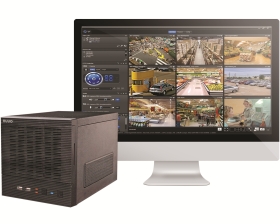

The shift from analogue to IP cameras created a surveillance industry revolution. It opened new possibilities, brought better benefits, but also created new technical challenges.
Not so long ago, it was easy comparing DVR systems head-on with specifications listed side by side. However, the debut of the network video recorder (NVR) and IP cameras opened up a much broader technical spectrum to choose from and finding the right solution became a much more difficult task.
The ability to faithfully record an event and store that event data might sound like a basic function for NVR products. But in actual experience this is often far from true. Data throughput consistency is an often overlooked aspect in NVR product evaluations. Imagine the consequences of video frames dropping out at the critical moment during an investigation, or important transaction footage disappearing due to an unstable recording system.
NVR stability can be gauged by its data throughput. A stable NVR should maintain a consistent data throughput unaffected by user actions such as querying or playback. It also would have a file handling routine to efficiently manage the large amounts of files on disks. So just what is throughput and how does it affect NVR performance?
A real story
Let’s illustrate how throughput could have a decisive impact on NVR system with a real-life scenario. Jose Marita is a general store manager in Cleveland, Ohio. He owns several small convenience stores around the city.
One day in November, Jose drove to work and found his office window broken and the safe deposit box underneath his desk wide open. Upon police investigation review, he found that two thugs broke into his office around dusk. The suspects were, however, unidentifiable because the jerky surveillance video footage stuttered and even blacked out during the moments when the burglars broke in. There were no signs of camera tampering and technical investigators concluded that Jose’s office surveillance was essentially unusable due to the constant data throughput drop.
Why throughput drops
Simply put, disk throughput is how much and how fast data can move from computer A to computer B. In NVR terms this equates to the file transfer rate of video data from IP cameras to hard disks in the NVR. When throughput drops, chunks of data may be dropped. A throughput drop could mean seconds, or even minutes, of valuable footage loss.
Many factors can impact throughput and create a system bottleneck. Although throughput may be affected by elements such as insufficient RAM, data size, or user actions, when investigating why throughput bottlenecking happens, we attribute the inability to guarantee throughput bandwidth to current file systems’ method of recycling disk space.
Conventionally, when a hard drive fills up and the camera continues to record data, the computer will attempt to free up space by deleting files on the disk, starting with the oldest. This is fine for typical usage but the process is lengthy and resource intensive. Available remaining disk space must be constantly monitored while a simultaneous querying action happens in an attempt to sort the files by their age. This action is what creates a drop in data throughput and causes the entire system to freeze up for a few seconds. (In the meantime footage disappears.)
The NUUO solution
NUUO labs identified this flawed process and proposed a fixed data block solution – the NUUO File Ring.
Using the NUUO File Ring, all video data are divided into fixed-size blocks, each tagged with a unique ID number. The simple design concept behind this solution is that if the action of deleting files off the hard drive creates a system bottleneck, by predefining and tagging data blocks, the computer would no longer need to delete or move files. The file system will instead begin to overwrite file blocks starting with the smallest sequential number when drive capacity approaches the limit.
Keeping files in uniform size also means faster file indexing. File count is also reduced in record-on-event scenarios due to the fixed data block size. Any pre-record and post-record data can potentially be stored together inside one file block instead of many small file fragments, each containing only a few seconds of video data.
In the process of creating the NUUO File Ring, the company’s engineers also improved other areas that help maintain throughput consistency. A dedicated cache mechanism for query and playback was created in addition to improved memory buffer resource allocation for record-on-event reminders.
NUUO’s flagship enterprise solution Crystal Titan uses File Ring technology and the test results show uncompromised data throughput consistency. NUUO is distributed in South Africa by Forbatt SA.
| Tel: | +27 11 469 3598 |
| Email: | [email protected] |
| www: | www.forbatt.co |
| Articles: | More information and articles about Forbatt SA |

© Technews Publishing (Pty) Ltd. | All Rights Reserved.